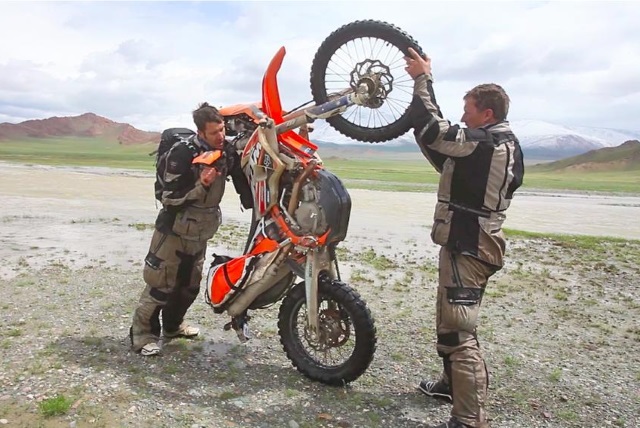
Dirt bikes don't run under water.
OK, just thought you'd want to know.
But if you ever decide to ride that thin patch of dry land surrounded by a natural forming swimming pool or think the small pond ahead is merely an obstacle that needs its comeuppance then you've come to the right place.
A sunk dirt bike in water with the white sputtering smoke out the tail end is often the star of all those dirt bike fail compilation videos. It's never going to happen to you but when it does you quickly realize the mess you're in. Time is not on your side and if you've ever tried standing a submerged dirt bike upright you're in for a nasty surprise. Because when you do get it back on two wheels, now you have to get it out of the water. A thick muddy bottom adds insult to certain dirt bike injury.
Hopefully you've got a riding buddy.
Manufacturers design dirt bikes to ride in wet conditions. If not, those awesome mud battles that we get to watch at least once a year in Motocross would cease to exist. However, full submersion is another story. You know the tailpipe where the smoke comes out? That leads right to the engine and water always finds the path of least resistance.
So, if you drop your dirt bike in the drink, get it out of the water quickly. Once on dry land, tip the bike upwards on the back wheel (like a wheelie) to drain the water. Then remove the spark plug and flip the bike upside down so it's resting on the seat and handlebars. Use your hand to push the kickstarter several times which helps push water out of the motor.
Photo: Rideasia.net
If you're lucky, it just might start. And, if it does, you're good to go but it's probably best to change the oil later just to be safe. Most electrical components, the engine housing and other vital compartments are sealed and can withstand brief submersion. You can ride dirt bikes in the rain so in many respects a quick dip is not too much different than riding for 30 minutes in a downpour.
However, long term submersion eventually allows water to creep into the engine and its usually cold water and you know what happens when a hot engine and cold water collide. (Even a relaxing 70 degree pond in the middle of summer is considered cold to a blistering hot engine.) Severe engine damage ensues. Once in the crankcase water contaminates the oil and on a carbureted dirt bike water fills the float bowl. You're also likely dealing with a water-saturated air filter and eventually the electrical components get damaged. If it doesn't start after you've tipped the bike up and drained the water, walk it home and get to work.
Perform a complete maintenance overhaul.
- Change the oil and oil filter
- Change the air filter
- Change the coolant
- Replace the exhaust packing
Once the maintenance overhaul is complete, start the engine. If it fires up, you're still not out of the woods. If any water remains in the crankcase despite the oil change, it could cause problems later, usually with the bearings not getting enough lubrication. Poor performance like stalling, bogging or hesitation likely means water in the fuel system, air system and/or electrical system. If this happens try a high quality fuel to rule out the fuel system problem otherwise leave your bike in a dry and well ventilated area for an extended period of time.
If it simply doesn't start you're looking at a complete engine rebuild. If your level of expertise allows it, grab a new top end kit or better yet perform a complete engine overhaul with a top and bottom end kit.
Finally, if your luck ran out, in a worst case scenario, it's a bent rod or valve that's preventing the engine from turning over. A relatively easy fix considering the alternative but a professional mechanic is your best bet. Expect a dent in your wallet but at least you don't need to shell out for a new dirt bike.
Unless that was the plan all along.









